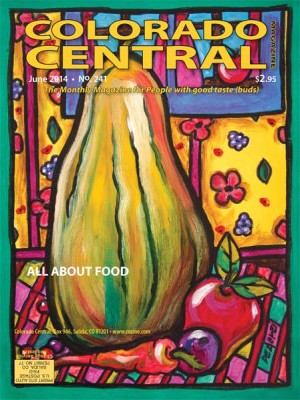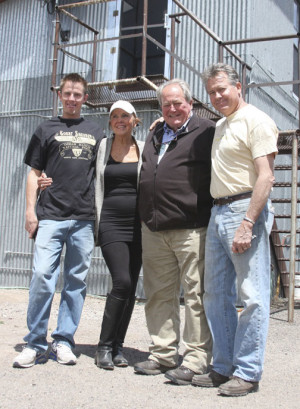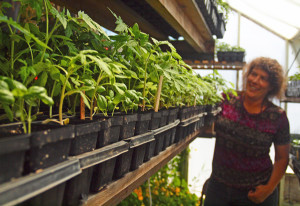By Hal Walter
My interest in locally grown foods began about 14 years ago. I had long held the belief that the highest-quality foods were essential to optimal health, fitness and brain function, and that eating well also was part of living life to its fullest.
I was at the annual Pueblo Chile Festival when I spied a small table. There were two farmers there and they didn’t really have much for sale, but I think I bought some onions and something else, and they told me some of their story. They were from an outfit called Tres Rios Co-op, and their names were Dan Hobbs and Doug Wiley. I think it was Dan who handed me a business card.
Being the curious sort, months later I decided to pay Dan a call. I ended up at Hobbs Family Farm near Avondale out east of Pueblo, where I bought a boxful of vegetables. Lo and behold Doug showed up there, too. I mentioned that I was also looking for some hay and Doug said he had some for sale. So we drove over to his Larga Vista Ranch where I bought a pickup load of alfalfa and some pork chops.
Thus began my long involvement with these two farmers and an organization that evolved to become Arkansas Valley Organic Growers, named for its association and dependence on the Arkansas River for water. The notion is that in the arid West, a regional “food shed” could be defined by the watershed in which the food is grown.
In the following years I’d also become acquainted with other farmers and their farms – Beki Javernick-Guion at Family Roots Farm in Canon City, Jay Frost of Frost Farm near Fountain, Susan Gordon and Patrick Hamilton of Venetucci Farm in Colorado Springs, and Ryan and Betsy Morris of Country Roots Farm in Pueblo.
The relationship evolved into a work opportunity – I wrote and produced marketing materials for the group. The food was clearly better than anything in the groceries, but the biggest missing piece to the marketing puzzle was always how to make this food more conveniently available to the public.
For me this inconvenience was always overshadowed by the food itself. Dan produces organic garlic that gushes with juice when you crush a clove, and cherry tomatoes that are out of this world. Doug grows the most flavorful Italian peppers, chile and melons I’ve ever eaten. They and the other producers raised an incredible variety of some of the most amazing produce I’ve ever tasted – and all of it grown with water from the Arkansas River Watershed.
I realize for many people this choice is not so simple. Local food is not a priority, or is just too inconvenient. Price is a consideration. We are conditioned to buy our food at supermarkets. And we live in a world where we don’t even realize most of our food travels long distances before it reaches our tables. If it ever reaches a table at all – how many of us eat while we’re driving? How many of us think about where that food comes from and who grows it?
As Colorado Centralists, we also live in somewhat of a food desert. If left to survive on what is produced here, many of us would suffer. Sure, we can grow meat here, and some produce and grains, but what is grown here is not likely to support the population year-round. At least not very well.
The term locavore refers to people who are interested in food that is grown locally and not transported great distances. There are many takes on this notion, from those who refuse to eat anything not grown in their immediate zip code to those who just shop at farmers markets whenever they can.
For me, being a locavore means supporting local farmers in our food/watershed as much as possible, and also taking it a little further. For instance, I am involved in raising my own beef and do my best to garden at this altitude (you can’t get more local than growing something yourself), and I also try to buy as much local produce as is seasonally possible. In the fall I also buy as much local food as I can afford to store into the winter months. Onions, winter squash and garlic are things I buy in bulk. I also buy as many bushels of Doug’s peppers as I can afford and fit in my freezer.
When I do this I am making a conscious effort to support my own health and nutrition. I’m also supporting local businesses (farms are businesses too!) and the local economy (farmers spend money locally, too!).
This takes a little more effort than just going to the grocery. I have to either go to the farm, meet the AVOG truck somewhere for pickup, or visit a farmers market or local foods store like Ploughboy in Salida. I think some people view this as a crazy or far-out way to shop for food but it is not, and there’s a trend afoot.
Like locavore, another term relating to locally grown foods that you will surely be hearing more about in the future is a “regional food hub,” which is a business or organization that actively manages the aggregation, distribution and marketing of food products primarily from local and regional producers to satisfy wholesale, retail and institutional demand. In this respect, Ploughboy in Salida is a food hub. So is the newly opened Excelsior Farmers Exchange operated by NewFarms and AVOG east of Avondale.
The United States Department of Agriculture has identified regional food hubs as an increasingly economically viable solution to the problems of distribution and processing facing small- to medium-sized farms. One recent study conducted on a 16-county area of northeast Ohio determined that meeting 25 percent of food needs locally would generate more than 27,000 new jobs in the area, employ one in eight unemployed residents, generate $4.2 billion in revenues and $126 million in state and local taxes.
What’s incredibly exciting about this is the notion of private businesses and organizations finding opportunity in fulfilling this missing niche – solving the puzzle – of making local foods more conveniently and consistently available to the general public.
Taking local food mainstream is still a long row to hoe, but it’s sure come a long way since I first got involved. During this journey I had the pleasure to interview Mike Callicrate, local foods proponent and owner of Ranch Foods Direct in Colorado Springs. Mike has provided input on a number of documentaries about our food supply.
“What we support prospers; what we feed grows,” Mike says, noting our country is losing 1,000 ranches per month while most people shop for the lowest price on food at big retail chains. The result, he says, is predictable.
“Aggressive price shopping is so contrary to our own well-being,” says Mike. Feeding the factory-food beast leads to an erosion of jobs, small businesses and ultimately the community. “When you buy good stuff from those earning a living wage, you have a more prosperous environment.”
Amen.




